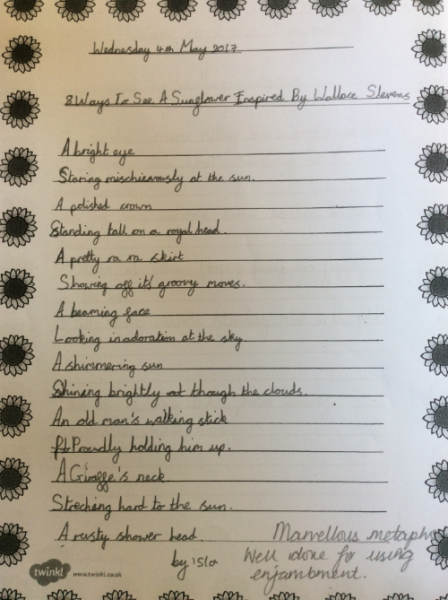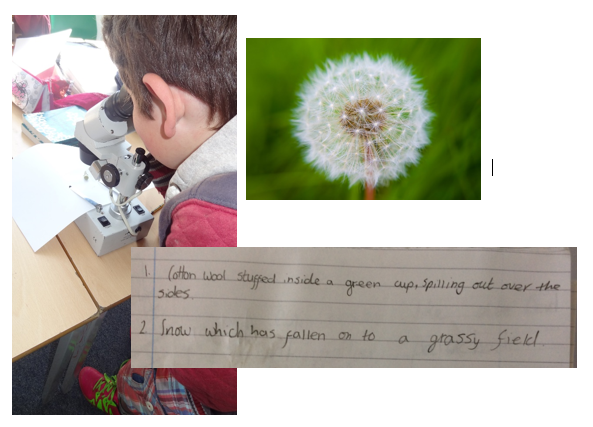- Latest NewsUp-to-date articles giving you information on best practice and policy changes.
- Skills AuditsEvaluate your skills and knowledge, identify gaps and determine training needs.
Inspiring cross curricular writing: the poetics of science and geography
Is it possible to get poetical about science? Dr Verity Jones shares creative and inspirational ways to integrate literacy into science and geography lessons
SATs. What can we learn from the results of the tests and what more can we do to prepare our pupils? Oxford University Press asked hundreds of teachers just that. And the conclusion? Comprehension and writing held the greatest challenge for most teachers and pupils in the 2017 tests.
In preparing for next year's tests, teachers say they need even greater a focus on:
- comprehension
- SPAG
- mastery.
Three little words (okay, one is an acronym) that for many will do nothing more than reinstate the cold sweats and palpitations of Year 2 and Year 6 teachers. Surely we can’t do more?
One of the recurring themes that comes up in my discussions with teachers and senior leaders is the breadth of writing and reading their pupils are doing, and have access to – or more usually the lack of these opportunities.
While literacy lessons are jam packed with grammar, adventures, myths, historical fiction, instructions, explanations and so on, many schools are neglecting the potential for using other curricula areas to practise and develop these skills.
Key questions
How can we better develop subject specific input, so we can use this time to critically assess how pupil’s writing and comprehension is developing? What would this look like in the classroom?
Recently I have supported a number of primary schools in developing poetry; in particular bringing science and poetry together to engage pupils and enable literacy and scientific progress.
This is particularly pertinent at a time when schools in England are faced with the reintroduction of Science SATS (initial sampling being undertaken in June 2018), while teacher confidence and subject knowledge are low.
Scientific skills: the poetics of looking with Rossetti
What is pink? a rose is pink
By the fountain's brink.
What is red? a poppy's red
In its barley bed.
What is blue? the sky is blue
Where the clouds float thro'.
What is white? a swan is white
Sailing in the light.
What is yellow? pears are yellow,
Rich and ripe and mellow.
What is green? the grass is green,
With small flowers between.
What is violet? clouds are violet
In the summer twilight.
What is orange? why, an orange,
Just an orange!
By Christina Rossetti
Considering the skills, or themes, you wish to develop within science can be a way into thinking about how to engage and enable cross curricula writing that is so much more than an instruction or explanation text.
Christina Rossetti’s poem 'What is pink?' is a favourite in KS1 classrooms due to its simple repetition and rhyming scheme, with a surprising ending. However, used creatively, this could be a springboard into observations and deeper thinking higher up the school.
Lesson ideas: identify and categorise
KS1 pupils can identify, group and categorise similarities and differences in materials, plants and animals based on colour. They can create their own poems inspired by this enquiry, following the language and rhyme patterns within the original text.
KS2 pupils could use their work on rock identification to think through the use of different rock types from the large classes of igneous, metamorphic and sedimentary, or more specific specimens, such as granite or slate.
What is sedimentary? Limestone is sedimentary
Used for stonework across the country.
What is slate? A roof tile is slate
Sedimentary rocks heated as flat as a plate.
What is talc? Talc is talc
Why lovely, powdery talc.
Scientific skills: the poetics of looking with Stevens
1. The hut stands by itself beneath the palms.
2. Out of their bottle the green genii come.
3. A vine has climbed the other side of the wall.
4. The sea is sprouting upward out of rocks.
5. The symbol of feasts and of oblivion...
6. White sky, pink sun, trees on a distant peak.
7. These lozenges are nailed-up lattices.
8. The owl sits humped. It has a hundred eyes.
9 The coconut and cockerel in one.
10. This is how yesterday’s volcano looks.
11. There is an island Palahude by name—
12. An uncivil shape like a gigantic haw.
By Wallace Stevens
In the summer and autumn terms, school science often looks at ‘living things and their habitats’ – trying to take advantage of the good weather and the possibility of outside fieldwork.
To encourage looking in greater detail, choosing language and using imagery (in this case metaphor), I have found Wallace Stevens’ 'Someone Puts a Pineapple Together' to be a great poem to engage learners and get them thinking differently.
Set out as 12 statements, it is not immediately recognisable as a familiar form of poetry but pupils quickly grasp the concept and enjoy thinking about how a pineapple does look as if 'The sea is sprouting upwards out of rocks.'
Lesson ideas: metaphor and microscope
KS2 pupils can read the poem and work on developing direct metaphor. Take care: the tendency is to slip into simile and you end up with a poem full of ‘it’s like…’ repeated many times.
This poem can be used as part of a healthy eating unit, as a lead in to tasting pineapples, or to encourage observation and comparison to other plants.
For example, this Year 3 pupil looked carefully at the sunflowers they had grown, after reading Stevens' poem.

This poem has been equally successful with older pupils where I have used it as a KS2/3 transition lesson. Using microscopes (borrow from a secondary school or use the science lab on a transition visit) means pupils can look more closely at something. For example, the seed heads of a dandelion are particularly interesting. Or I collect the dead insects that are lying around the window sills of the classroom (!) and look at them.
Whatever goes underneath the lens opens up a whole new world of seeing, and a whole new world needing to be described.

Poetry in every subject
We cannot ignore the skills and content which are demanded to be taught, but we need to think of ways in which these can be encapsulated in strategies and activities that develop thinking in new and interesting ways across the curriculum.
By its very nature, poetry is flexible enough to be used in such a way, and can implemented easily into any subject specific lesson which relies on some reading through activities like blackout poetry.
Lesson idea: blackout poetry
KS2 and KS3 pupils can be given a sheet of text to read (this could be an extract from a report, newspaper, biography, recipe book, story etc.). Ask them to create a blackout poem, circling words or short phrases they wish to keep which will add their voice over the top of the text.
The words that are unused in the piece can literally be blacked out (see the work of Austin Kleon for examples). This is a simple and effective way of working on skimming, scanning, vocabulary choice and authorial intention.
Poetry to inspire and engage
On occasion a particularly difficult, dry, or to some, boring, piece of subject knowledge will need to be communicated to our pupils. On such occasions, the manner in which we introduce the theme can be the point at which our learners either engage or switch completely off. Using poetry can provide a valuable route in.
Take for example learning about rivers. This could be done through a text book or perhaps a documentary film. But what about using a poem for a change?
The work of Ian Hamilton Findlay is both simple and thought provoking. He uses words in patterns, often inscribed onto the very landscape itself. Or try using Carol Ann Duffy’s anthology of poetry about climate change, Keep it in the Ground.
Using poetry as a way of opening the door to new and difficult areas of learning can offer learners alternative opportunities to understand and express themselves. (See this collection of geography poems for example. Or why not create an online library of geography poems with your pupils?)
I believe that with a refocus on developing subject specific input and activities creatively, we can use time outside of dedicated literacy lessons to critically assess how pupil’s writing and comprehension is developing, and further enhance the opportunities of the learners in our classrooms.
Last Updated:
21 Mar 2019


